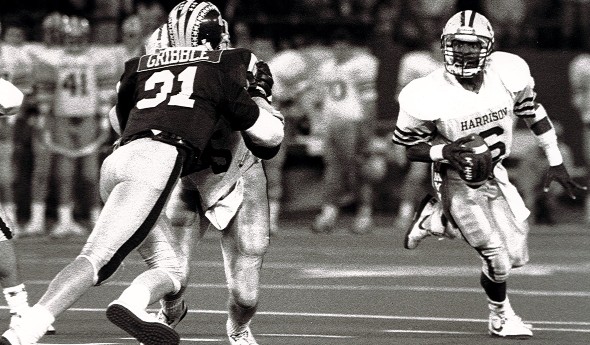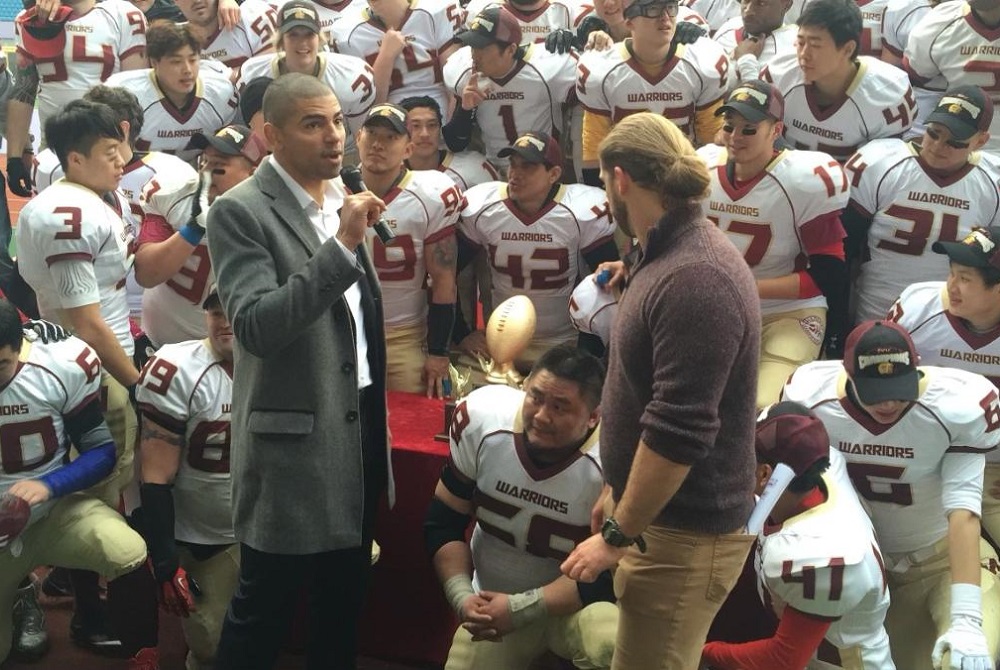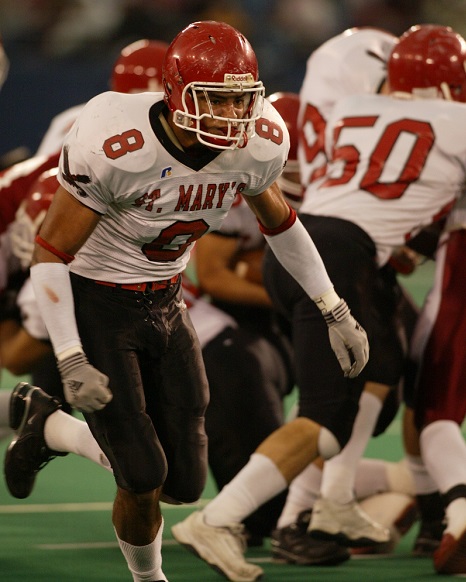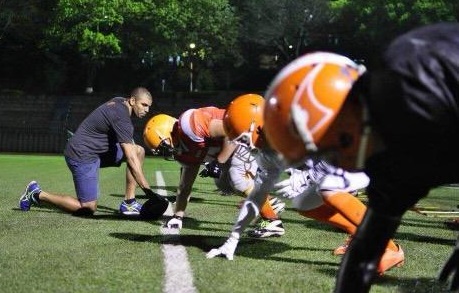
Moment: The Final Thrill
December 16, 2020
By John Johnson
MHSAA Director of Broadcast Properties
Over the course of nearly 34 years on this job, you often get asked what single championship game you would rank at the top of your list. You could ask that question to 100 people and get 100 answers – and guess what? They’d all be right. Such is the beauty of high school sports.
Which is why, after all these years, my game for the ages is one that has stood the test of time in my mind for over 30 years. It had everything you would want in a high school game – fantastic competition – great plays – and when it was over, some of the best sportsmanship I’ve ever seen – NO – make that THE best sportsmanship I’ve ever seen. To be on the field, you’d have a hard time telling who won and who lost by the way the players from both teams hugged and shook hands and sincerely congratulated each other. Which is how it should be after every – single – game.
And what topped it all off after that was the winning team making a trip to a pep assembly at the other team’s gym the following week to thank them for a great game, and present a banner signed by every member of the team.
That game was the 1989 Class B Football Playoff Final. The last year that four divisions were conducted in that postseason tournament. The last game played in that format.
Farmington Hills Harrison and DeWitt. The powerful, dominant Hawks and even legendary at that time coach John Herrington – and the All-America quarterback in Mill “The Thrill” Coleman; against the pride of the Ingham County League, the Panthers of DeWitt, from what was an old farming bedroom community north of Lansing transforming into a new money suburb of the Capitol City.
The Hawks, the reigning Class B champs after winning the third of their state-record 13 titles against St. Joseph the previous November, were heavy favorites. DeWitt was making its fourth Playoff appearance and moving up in class after reaching the Semifinals in 1988, only to lose to powerhouse Detroit St. Martin dePorres.
The underdogs used an efficient running attack to take a 21-14 halftime lead on Harrison. John Telford, who rushed for 153 yards in the game, had two of the scores. Harrison tied the game early in the final period on the first of two scoring runs by Coleman, this one from 19 yards out.
DeWitt then put together a grinding drive, culminated by quarterback Chris Berkimer sneaking it from one yard out. Harrison blocked the extra point and DeWitt led 27-21 with 2:20 on the clock.
That left way too much time for Coleman. He engineered a 67-yard, five-play drive to tie the game. It didn’t even take a minute off the clock.
“When they scored I looked at the clock and knew we had enough time and all three of our time outs,” Coleman told the Detroit Free Press after the game. “I kept thinking back to that drive John Elway had against the Browns a couple of years ago in the playoffs when he had to go 98 yards.”
Three straight passes to Mike Saputo, Steve Hill and Greg Piscopink got Harrison down to the DeWitt 16; and Coleman then rolled out on a Student Body Right for another seven yards.
At the DeWitt 9, Coleman dropped back for what appeared to be another pass, but the Panthers' pressure forced The Thrill to run. Coleman eluded five tacklers along the way, finally diving into the end zone to score.
“We knew he (Coleman) was good, and we just tried to contain him,” DeWitt coach Gail Thornton told the Lansing State Journal after the game. “But every once in a while he would get loose for a big one.”
Steve Hill kicked the extra point and Harrison was back in the lead, 28-27. Hill would then intercept Berkimer on DeWitt’s first play after the ensuing kickoff to seal the deal.
PHOTO: Farmington Hills Harrison's Mill Coleman rolls left at the start of what would be the game-winning run for his team in the 1989 Class B Football Final. (Photo by Gary Shook).

St. Mary's Standout McLaurin Becomes Chinese Football Pioneer
By
Tom Markowski
Special for Second Half
August 19, 2021
The eight years Chris McLaurin spent in China not only changed his life, but they changed the perception of American football in China and elsewhere – and just may have opened the door to a whole new market.
 We're talking “American football,” not soccer. Most of us are familiar with NFL Europe, but NFL China? Not so much.
We're talking “American football,” not soccer. Most of us are familiar with NFL Europe, but NFL China? Not so much.
When McLaurin went to China in 2011, the thought of teaching the locals American football never occurred to him. He went there to work for a private company, and circumstances just seemed to fall in place.
Some might say McLaurin was in the right place at the right time, but it can also be said he was the right person at the right time to lead this undertaking. McLaurin had the background, both athletically and organizationally, to take on such an endeavor.
“I met a lot of people who were interested in football,” McLaurin said. “I thought, football? I had a limited understanding of what they knew. I was very surprised they would reach out to me. I quickly found out they were hungry to learn.”
A 2005 graduate of Orchard Lake St. Mary's, McLaurin started at tight end and linebacker, and helped the Eaglets reach the MHSAA Division 2 Final in 2004 (where they lost to Muskegon). McLaurin went on to play four seasons at Michigan and graduated in 2009 with a degree in history and minor in urban and community studies. He had thoughts of entering law school when other opportunities interceded.
During his time in Ann Arbor, McLaurin worked with an organization that focused on disadvantaged youth in the area and helped open doors for them. They were allowed to attend lectures at the university as well as sporting events.
Upon graduation, the seeds that would blossom in Asia began being sown in other parts of the world.
McLaurin received a Fulbright Scholarship and went to Johannesburg, South Africa, to work with underprivileged youth as part of a program called Tomorrow Trust. During this time he worked with the United Nations Development Programme and Harvard Law School in their pursuit of promoting economic rights for the poor.
Following his work in South Africa, McLaurin began his post-graduate work at the London School of Economics. He earned his degree after working in the House of Commons and as a research assistant for the Runnymede Trust. Then came a six-month internship within the Obama Administration as part of the White House Domestic Policy Council.
And after that, he was off to Chongqing in western China to work for a private equity company as a project manager. Two years later, he started his own company in addition to a non-profit organization. Much of his work centered on the automobile industry and global technology.
During this time he learned to speak Mandarin and, in doing so, was introduced to more of the local customs – including American football.
 What McLaurin found was a rudimental brand of football, what we would term a recreational type of competition. McLaurin began his involvement gradually, on weekends.
What McLaurin found was a rudimental brand of football, what we would term a recreational type of competition. McLaurin began his involvement gradually, on weekends.
“After that first year (2012), I took it up a notch,” McLaurin said. “We started recruiting players and bought new equipment. They watched football on TV, but it's not an easy game to understand. You have to play football to learn it. You don't get that from watching TV.”
A year of training, recruiting and, yes, some frustration, led McLaurin to start a league, the American Football League of China (now known as the China National Football League). The rules are similar to those at the U.S. college level. There are 11 players a side, and when a ball carrier's knee touches the ground the play is over.
In the beginning “it was successful,” he said. “There were no leagues when I got there. There was no one to organize it. We went from (fewer than) 10 teams to, 3-to-4 years later, there are 80-90.”
McLaurin quickly learned he needed help if this adventure was to succeed. USA Football had a footprint in Shanghai, and McLaurin reached out to the organization. McLaurin contacted a handful of former teammates including Prescott Burgess and Morgan Trent for advice. Former NFL player Bruce Plummer and NFL coach and scout Jerry Hardaway worked some of the camps and clinics with McLaurin and added much-needed experience and expertise.
After playing at Southern Illinois, Hardaway’s first coaching position was at Memphis State as an assistant, and then he went to Grambling State to coach under the legendary Eddie Robison for six seasons. He also coached at the University of California under Joe Kapp prior to working in the NFL and then heading to China.
“I was told, through another guy, that (McLaurin) needed some help,” Hardaway said. “It was all about getting back to basics. That's what made it fun. They had no clue when you'd say to them, control the ground at impact when you're making a block. They had no idea of the terms that you'd use. To see the young kids, to see on their faces, they were absorbing everything.
 “Yes, yes, yes, it was worthwhile. First of all, people had no clue about what it takes to do something like this. They were learning. Some of the parents thought it was a violent sport. That's what they heard. Then they switched. They saw me, us, teach the basics and they saw what we were doing. For me, it gave me a sense, like hey, you have to teach and you have to enjoy it.”
“Yes, yes, yes, it was worthwhile. First of all, people had no clue about what it takes to do something like this. They were learning. Some of the parents thought it was a violent sport. That's what they heard. Then they switched. They saw me, us, teach the basics and they saw what we were doing. For me, it gave me a sense, like hey, you have to teach and you have to enjoy it.”
Soon after that first season, the NFL got involved as did the National Committee on United States - China Relations. McLaurin credits the NFL for advising him on the business end of starting a new league and structuring. After 18 months, McLaurin got out of coaching and became the commissioner.
“(The NFL) wanted to expand,” he said. “They saw how their brand was quite low (in China). China is a natural.”
Progress was slow, but it was still progress. The 2015 championship game was played in Shanghai, and McLaurin estimates it drew 3,500 spectators.
He continued to work with the AFLC through 2019 but then decided to make a career move. He returned to the U.S. and, this fall, is pursuing a dream he's held since leaving U-M. At age 34, McLaurin entered Harvard Law School.
“When I started, the last thing we wanted was a U.S. version of football,” he said. “We wanted it to be Chinese football. There were limitations on how many foreigners would compete. At first it was five (per team), then three. We wanted it to be a Chinese experience."
2020-21 Made in Michigan
August 5: Herremans' Focus on 'Dadding,' Giving Kids Similar Small-Town Childhood - Read
July 29: Loy Norrix Career Prepped Crocker for U-M Success, Law Degree Pursuit - Read
July 19: Top PGA Pro Finish Latest Greatest Highlight as Cook Continues Climb - Read
July 16: TC West Standout Renews Ties to Titans, Cheers Past Teammates' Gold Pursuit - Read
July 8: Caro Champs Find Common Ground Again as Mental Health Providers - Read
June 28: Michigan's Minor Leaguers Making Up for Lost Season - Read
PHOTOS: (Top) Former Orchard Lake St. Mary's standout Chris McLaurin started an American football league in China and remained part of its leadership through 2019. (Middle) McLaurin was a two-way starter for St. Mary's 2004 Division 2 runner-up team. (Below) McLaurin runs drills for one of the Chinese teams. (Top and below photos courtesy of Chris McLaurin; middle photo from MHSAA archives.)

